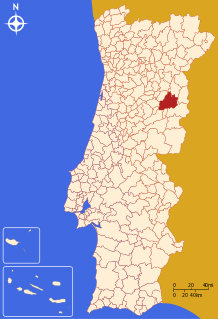Guarda, Portugal
Guarda (Portuguese pronunciation: [ˈɡwaɾdɐ] (![]()
Guarda | |
|---|---|
_(cropped).jpg) .jpg)  .jpg)  _(cropped).jpg) | |
 Flag  Coat of arms | |
 | |
| Coordinates: 40°32′N 7°20′W | |
| Country | |
| Region | Centro |
| Intermunic. comm. | Beiras e Serra da Estrela |
| District | Guarda |
| Parishes | 43 |
| Government | |
| • President | Carlos Chaves Monteiro |
| Area | |
| • Total | 712.10 km2 (274.94 sq mi) |
| Population (2011) | |
| • Total | 42,541 |
| • Density | 60/km2 (150/sq mi) |
| Time zone | UTC±00:00 (WET) |
| • Summer (DST) | UTC+01:00 (WEST) |
| Local holiday | November 27 |
| Website | http://www.mun-guarda.pt |
Geography
Guarda is the largest city in its district 9, capital of the Guarda District and the Beira Interior Norte Subregion within the Centro region. The municipality is bordered by Pinhel to the north, to the east by Almeida, to the southeast by Sabugal, to the south by Belmonte and Covilhã, to the west by Manteigas and Gouveia, and to the northwest by Celorico da Beira.
Guarda is the highest city in continental Portugal (altitude 1,056 m), located to the northeast of Serra da Estrela (the largest mountain in mainland Portugal). The main attraction in Guarda is its cathedral, known as the Sé da Guarda. Guarda is a diocese of the same name.
Guarda railway station is served by the railway line Linha da Beira Alta, with international services towards Salamanca and Madrid, and domestic services to Pinhel, Vila Franca das Naves/Trancoso, Celorico da Beira, Gouveia, Nelas, Carregal do Sal, Santa Comba Dão, Mortagua, Luso/Buçaco and Pampilhosa. The station at Guarda has (2013) eighteen daily arrivals and departures of passenger trains and there is a small freight terminal. The section of the Linha da Beira Baixa, which ran from Guarda through Belmonte/Sabugal, Covilhã, Fundão, Castelo Branco and Abrantes to Entroncamento, was closed in 2010 between Guarda and Covilhã. The track is now partially lifted, thus making it unusable.
The main motorways are A25 (Aveiro, Viseu, Guarda, Vilar Formoso) and A23 (Guarda, Covilhã, Fundão, Castelo Branco, Abrantes, Torres Novas). Numerous motorcoach (long distance bus) services use these motorways to link Guarda with Porto, Lisbon and other Portuguese cities.
Guarda is antipode of Puponga in New Zealand.
Climate
Guarda has a continental cool mediterranean climate[4] with lower average temperatures than most climates of this subtype, in part due to its high altitude.
| Climate data for Guarda, Portugal, 1981-2010 normals | |||||||||||||
|---|---|---|---|---|---|---|---|---|---|---|---|---|---|
| Month | Jan | Feb | Mar | Apr | May | Jun | Jul | Aug | Sep | Oct | Nov | Dec | Year |
| Record high °C (°F) | 15.2 (59.4) |
17.6 (63.7) |
23.0 (73.4) |
24.5 (76.1) |
30.8 (87.4) |
33.7 (92.7) |
38.3 (100.9) |
34.6 (94.3) |
36.0 (96.8) |
27.0 (80.6) |
21.3 (70.3) |
15.8 (60.4) |
38.3 (100.9) |
| Average high °C (°F) | 6.8 (44.2) |
8.6 (47.5) |
11.4 (52.5) |
12.4 (54.3) |
16.4 (61.5) |
21.2 (70.2) |
25.1 (77.2) |
25.0 (77.0) |
21.1 (70.0) |
15.0 (59.0) |
10.0 (50.0) |
7.8 (46.0) |
15.0 (59.0) |
| Daily mean °C (°F) | 4.0 (39.2) |
5.4 (41.7) |
7.6 (45.7) |
8.5 (47.3) |
12.0 (53.6) |
16.3 (61.3) |
19.5 (67.1) |
19.5 (67.1) |
16.5 (61.7) |
11.6 (52.9) |
7.5 (45.5) |
5.4 (41.7) |
11.1 (52.1) |
| Average low °C (°F) | 1.2 (34.2) |
2.3 (36.1) |
3.7 (38.7) |
4.6 (40.3) |
7.7 (45.9) |
11.3 (52.3) |
14.0 (57.2) |
13.9 (57.0) |
11.9 (53.4) |
8.3 (46.9) |
5.0 (41.0) |
2.9 (37.2) |
7.2 (45.0) |
| Record low °C (°F) | −10.8 (12.6) |
−6.2 (20.8) |
−8.0 (17.6) |
−3.8 (25.2) |
−1.8 (28.8) |
1.2 (34.2) |
4.4 (39.9) |
6.0 (42.8) |
3.5 (38.3) |
−0.6 (30.9) |
−7.5 (18.5) |
−6.7 (19.9) |
−10.8 (12.6) |
| Average precipitation mm (inches) | 104.8 (4.13) |
71.2 (2.80) |
59.4 (2.34) |
86.7 (3.41) |
86.3 (3.40) |
33.9 (1.33) |
18.2 (0.72) |
10.4 (0.41) |
58.2 (2.29) |
107.4 (4.23) |
127.1 (5.00) |
150.6 (5.93) |
914.2 (35.99) |
| Source: [5] | |||||||||||||

Parishes
The municipality consists of the following 43 parishes:[6]
- Adão
- Aldeia do Bispo
- Aldeia Viçosa
- Alvendre
- Arrifana
- Avelãs da Ribeira
- Avelãs de Ambom e Rocamondo
- Benespera
- Casal de Cinza
- Castanheira
- Cavadoude
- Codesseiro
- Corujeira e Trinta
- Faia
- Famalicão
- Fernão Joanes
- Gonçalo
- Gonçalo Bocas
- Guarda
- Jarmelo São Miguel
- Jarmelo São Pedro
- João Antão
- Maçainhas
- Marmeleiro
- Meios
- Mizarela, Pêro Soares e Vila Soeiro
- Panóias de Cima
- Pega
- Pêra do Moço
- Porto da Carne
- Pousade e Albardo
- Ramela
- Rochoso e Monte Margarida
- Santana da Azinha
- Sobral da Serra
- Vale de Estrela
- Valhelhas
- Vela
- Videmonte
- Vila Cortês do Mondego
- Vila Fernando
- Vila Franca do Deão
- Vila Garcia
References
- Instituto Nacional de Estatística
- "Áreas das freguesias, concelhos, distritos e país". Archived from the original on 2018-11-05. Retrieved 2018-11-05.
- Evans, David (2004). Portugal. New Holland Publishers. pp. 195. ISBN 9781860111266.
- "Guarda, Portugal Climate Summary". Weatherbase. Retrieved 22 March 2015.
- "1981-2010 Climate Normals - Guarda". IPMA. Retrieved 22 March 2015.
- Diário da República. "Law nr. 11-A/2013, pages 552 55-56" (pdf) (in Portuguese). Retrieved 9 July 2014.